Numerical Study on Compact Design in Marine Urea-SCR Systems for Small Ship Applications
Abstract
:1. Introduction
2. Numerical Conditions and Methods
2.1. Model Description
2.2. Numerical Models and Numerical Methods
2.2.1. Governing Equation
2.2.2. Porous Media Model
2.2.3. Urea Spray Model and Reaction Model
2.2.4. NOx Reduction Reaction Model
2.3. Boundary Conditions
3. Results and Discussion
3.1. The Velocity Distribution
3.2. The NH3 Distribution
3.3. The NO Distribution
3.4. Performance Comparison
4. Conclusions
- (1)
- The NO reduction rates of Cases 0–5 were 91.7, 52.1, 59.1, 77.5, and 84.8%, respectively. Compared to the conventional SCR system (Case 0), when the flow of the SCR system with an added DPF was changed from unidirectional to multidirectional and the overall length of the system was reduced by 1/3 (Case 1), the NO reduction rate was 39.6% lower than that of the conventional system. This is because the length of the mixing chamber through which the exhaust gas flows from the DPF to the SCR is too short to enable the sufficient completion of the NH3 conversion reaction.
- (2)
- To increase the NH3 conversion rate, the length of the mixing chamber was increased (Case 2). If the length of the system is reduced by half compared with that of the conventional model, the NO reduction rate increases to approximately 60%, which is still lower than that of the conventional system owing to the larger residence time in the conventional system. In Cases 1 and 2, the SCR filter comprised six stages of equal thickness but encountered a problem wherein most of the flow of exhaust gas leaving the DPF was concentrated in the last stage of the SCR filter.
- (3)
- To solve the problem of flow concentration in the last stage of the SCR, the thickness of the SCR filters was sequentially increased from the first stage (1) to the last stage (6) to increase the area at the rear of the SCR (Case 3). Consequently, the NO reduction performance was improved compared to that of the level of the conventional system. This represented an increase of approximately 80%.
- (4)
- When the shape of the mixing chamber was changed from square to circular to further increase the NO reduction rate (Case 4), the NO reduction performance increased by approximately 84.5%, while a pressure drop performance similar to that of the conventional model was achieved. Case 0 was equipped with only the SCR system, whereas Case 4 included a DPF with the same specifications as the SCR. Therefore, the pressure drop performance was reduced by 50% compared with that of the conventional system. As a result, the final redesigned model (Case 4) proposed in this study is expected to reduce the pressure drop by 50% compared with the conventional model while also reducing the length of the overall system by 50%, resulting in a suitably compact solution for application on small ships.
Author Contributions
Funding
Data Availability Statement
Conflicts of Interest
References
- Ni, P.; Wang, X.; Li, H. A review of regulations, current status, effects and reduction strategies of emissions for marine diesel engines. Fuel 2020, 279, 118477. [Google Scholar] [CrossRef]
- Jung, Y.; Pyo, Y.; Jang, J.; Woo, Y.; Ko, A.; Kim, G.; Shin, Y.; Cho, C. Nitrous oxide in diesel aftertreatment systems including DOC, DPF and urea-SCR. Fuel 2022, 310, 122453. [Google Scholar] [CrossRef]
- Viana, M.; Hammingh, P.; Colette, A.; Querol, X.; Degraeuwe, B.; de Vlieger, I.; van Aardenne, J. Impact of maritime transport emissions on coastal air quality in Europe. Atmos. Environ. 2014, 90, 96–105. [Google Scholar] [CrossRef]
- Deng, J.; Wang, X.; Wei, Z.; Wang, L.; Wang, C.; Chen, Z. A review of NOx and SOx emission reduction technologies for marine diesel engines and the potential evaluation of liquefied natural gas fuelled vessels. Sci. Total Environ. 2021, 766, 144319. [Google Scholar] [CrossRef]
- Kim, A.R.; Seo, Y.J. The reduction in SOx emissions in the shipping industry: The case of Korean companies. Mar. Pol. 2019, 100, 98–106. [Google Scholar] [CrossRef]
- Zhang, Q.; Wan, Z.; Hemmings, B.; Abbasov, F. Reducing black carbon emissions from Arctic shipping: Solutions and policy implications. J. Clean. Prod. 2019, 241, 118261. [Google Scholar] [CrossRef]
- Jeevahan, J.; Mageshwaran, G.; Joseph, G.B.; Raj, R.B.D.; Kannan, R.T. Various strategies for reducing NOx emissions of biodiesel fuel used in conventional diesel engines: A review. Chem. Eng. Commun. 2017, 204, 1202–1223. [Google Scholar] [CrossRef]
- Wang, X.; Gao, J.; Chen, H.; Chen, Z.; Zhang, P.; Chen, Z. Diesel/methanol dual-fuel combustion: An assessment of soot nanostructure and oxidation reactivity. Fuel Process. Technol. 2022, 237, 107464. [Google Scholar] [CrossRef]
- Chen, Z.; Li, K.; Liu, J.; Wang, X.; Jiang, S.; Zhang, C. Optimal design of glucose solution emulsified diesel and its effects on the performance and emissions of a diesel engine. Fuel 2015, 157, 9–15. [Google Scholar] [CrossRef]
- Chen, Z.; Wang, L.; Wei, Z.; Wang, Y.; Deng, J. Effect of components on the emulsification characteristics of glucose solution emulsified heavy fuel oil. Energy 2022, 244, 123147. [Google Scholar] [CrossRef]
- Wang, X.; Gao, J.; Chen, Z.; Chen, H.; Zhao, Y.; Huang, Y.; Chen, Z. Evaluation of hydrous ethanol as a fuel for internal combustion engines: A review. Renew. Energy 2022, 194, 504–525. [Google Scholar] [CrossRef]
- Jiaqiang, E.; Zhang, Z.; Chen, J.; Pham, M.; Zhao, X.; Peng, Q.; Yin, Z. Performance and emission evaluation of a marine diesel engine fueled by water biodiesel-diesel emulsion blends with a fuel additive of a cerium oxide nanoparticle. Energy Convers. Manag. 2018, 169, 194–205. [Google Scholar]
- Chybowski, L.; Laskowski, R.; Gawdzińska, K. An overview of systems supplying water into the combustion chamber of diesel engines to decrease the amount of nitrogen oxides in exhaust gas. J. Mar. Sci. Technol. 2015, 20, 393–405. [Google Scholar] [CrossRef]
- Larbi, N.; Bessrour, J. Measurement and simulation of pollutant emissions from marine diesel combustion engine and their reduction by water injection. Adv. Mech. Eng. 2010, 41, 898–906. [Google Scholar] [CrossRef]
- Sarvi, A.; Kilpinen, P.; Zevenhoven, R. Emissions from large-scale medium-speed diesel engines: 3. Influence of direct water injection and common rail. Fuel Process. Technol. 2009, 90, 222–231. [Google Scholar] [CrossRef]
- Larbi, N.; Bessrour, J. Measurement and simulation of pollutant emissions from marine diesel combustion engine and their reduction by exhaust gas recirculation. J. Mech. Sci. Technol. 2008, 22, 2263–2273. [Google Scholar] [CrossRef]
- Wang, Z.; Zhou, S.; Feng, Y.; Zhu, Y. Research of NOx Reduction on a Low-Speed Two-Stroke Marine Diesel Engine by Using EGR (Exhaust Gas Recirculation)–CB (Cylinder Bypass) and EGB (Exhaust Gas Bypass). Int. J. Hydrogen Energy 2017, 42, 19337–19345. [Google Scholar] [CrossRef]
- Thangaraja, J.; Kannan, C. Effect of exhaust gas recirculation on advanced diesel combustion and alternate fuels—A review. Appl. Energy 2016, 180, 169–184. [Google Scholar] [CrossRef]
- Choi, C.; Sung, Y.; Choi, G.M.; Kim, D.J. Numerical analysis of urea decomposition with static mixers in marine SCR system. J. Clean Energy Technol. 2015, 3, 39–42. [Google Scholar] [CrossRef]
- Gao, C.; Wang, Y.; Li, X.; Wang, S.; Ma, C.; Wang, X. Catalytic effect of diesel PM derived ash on PM oxidation activity. Chemosphere 2022, 299, 134445. [Google Scholar] [CrossRef]
- Gao, J.; Wang, Y.; Wang, S.; Li, X.; Chang, X.; Wang, X.; Yang, C.; Xuan, R. Effect of catalytic reactions on soot feature evolutions in oxidation process. Chem. Eng. J. 2022, 443, 136392. [Google Scholar] [CrossRef]
- Caiazzo, G.; Langella, G.; Miccio, F.; Scala, F. An experimental investigation on seawater SO2 scrubbing for marine application. Environ. Progress Sustain. Energy 2013, 32, 1179–1186. [Google Scholar] [CrossRef]
- Kuang, M.; Hu, X.; Yang, G.; Wang, J.; Yuan, G.; Tao, C.; Wu, S.; Ding, J.; Meng, X. Seawater/alkaline liquid cascade-scrubbing desulfurization performance for the exhaust gas of a 162-kW marine diesel engine. Asia-Pac. J. Chem. Eng. 2019, 14, e2370. [Google Scholar] [CrossRef]
- Zhu, Y.; Xia, C.; Shreka, M.; Wang, Z.; Yuan, L.; Zhou, S.; Feng, Y.; Hou, Q.; Ahmed, S.A. Combustion and Emission Characteristics for a Marine Low-speed Diesel Engine with High-pressure SCR System. Environ. Sci. Pollut. Res. 2020, 27, 12851–12865. [Google Scholar] [CrossRef]
- Kamil, M.S.; Muslim, M.; Saat, A.M. Effective control of SOx and NOx release to the atmosphere from emissions of ship propulsion engines. In Advancement in Emerging Technologies and Engineering Applications; Springer: Berlin/Heidelberg, Germany, 2020; pp. 91–100. [Google Scholar]
- Johansson, L.; Ytreberg, E.; Jalkanen, J.-P.; Fridell, E.; Eriksson, K.M.; Lagerström, M.; Maljutenko, I.; Raudsepp, U.; Fischer, V.; Roth, E. Model for leisure boat activities and emissions—Implementation for the Baltic Sea. Ocean. Sci. 2020, 16, 1143–1163. [Google Scholar] [CrossRef]
- Carreño, A.; Lloret, J. Environmental impacts of increasing leisure boating activity in Mediterranean coastal waters. Ocean Coast. Manag. 2021, 209, 105693. [Google Scholar] [CrossRef]
- Feng, S.; Li, Z.; Shen, B.; Yuan, P.; Ma, J.; Wang, Z.; Kong, W. An overview of the deactivation mechanism and modification methods of the SCR catalysts for denitration from marine engine exhaust. J. Environ. Manag. 2022, 317, 115457. [Google Scholar] [CrossRef]
- Lu, D.; Theotokatos, G.; Zhang, J.; Tang, Y.; Gan, H.; Liu, Q.; Ren, T. Numerical investigation of the high pressure selective catalytic reduction system impact on marine two-stroke diesel engines. Int. J. Nav. Arch. Ocean 2021, 13, 659–673. [Google Scholar] [CrossRef]
- Zhu, Y.; Li, T.; Xia, C.; Feng, Y.; Zhou, S. Simulation analysis on vaporizer/mixer performance of the high-pressure SCR system in a marine diesel. Chem. Eng. Process.-Process Intensif. 2020, 148, 107819. [Google Scholar] [CrossRef]
- Sung, Y.; Choi, M.; Park, T.; Choi, C.; Park, Y.; Choi, G. Synergistic effect of mixer and mixing chamber on flow mixing and NOx reduction in a marine urea-SCR system. Chem. Eng. Process.-Process Intensif. 2020, 150, 107888. [Google Scholar] [CrossRef]
- Um, H.S.; Kim, D.; Kim, K.H. Numerical study on the design of urea decomposition chamber in LP SCR system. Int. J. Nav. Archit. Ocean Eng. 2019, 11, 307–313. [Google Scholar] [CrossRef]
- Wardana, M.K.A.; Lim, O. Investigation of ammonia homogenization and NOx reduction quantity by remodeling urea injector shapes in heavy-duty diesel engines. Appl. Energy 2022, 323, 119586. [Google Scholar] [CrossRef]
- Liu, X.; Yan, F.; Zheng, S.; Liao, J.; Cai, Z.; Hu, J. Spray strategy and mixer optimization in Urea-SCR system based on frozen flow modeling. Chem. Eng. Process. Process Intensif. 2022, 172, 108810. [Google Scholar] [CrossRef]
- Bayramoğlu, K.; Özmen, G. Design and performance evaluation of low-speed marine diesel engine selective catalytic reduction system. Process Saf. Environ. Prot. 2021, 155, 184–196. [Google Scholar] [CrossRef]
- Guan, B.; Zhan, R.; Lin, H.; Huang, Z. Review of state of the art technologies of selective catalytic reduction of NOx from diesel engine exhaust. Appl. Therm. Eng. 2014, 66, 395–414. [Google Scholar] [CrossRef]
- Lamas, M.; Rodriguez, C. Numerical model to analyze NOx reduction by ammonia injection in diesel-hydrogen engines. Int. J. Hydrogen Energy 2017, 42, 26132–26141. [Google Scholar] [CrossRef]
- Park, T.; Sung, Y.; Kim, T.; Lee, I.; Choi, G.; Kim, D. Effect of static mixer geometry on flow mixing and pressure drop in marine SCR applications. Int. J. Nav. Archit. Ocean Eng. 2014, 6, 27–38. [Google Scholar] [CrossRef]
- Ye, J.; Tan, G.; He, Z.; Alex, F.J.; Peng, D.; Zhang, Z. Optimization of the Urea SCR injector based on entropy generation minimization and entransy dissipation extremum. Int. J. Heat Mass Transf. 2023, 205, 123935. [Google Scholar] [CrossRef]
- Mehdi, G.; Zhou, S.; Zhu, Y.; Shah, A.H.; Chand, K. Numerical investigation of SCR mixer design optimization for improved performance. Processes 2019, 7, 168. [Google Scholar] [CrossRef]
- Zhang, Q.; Fan, Y.; Li, W. Numerical simulation and experimental verification of chemical reactions for SCR DeNOx. Front. Chem. Eng. China 2010, 4, 523–528. [Google Scholar] [CrossRef]
- Chin, T.; Tam, I.; Yin, C.-Y. Wet scrubbing process with oxidation and reduction in series for removal of SO2 and NO from marine diesel engine exhaust. Chem. Eng. J. 2023, 464, 142299. [Google Scholar] [CrossRef]
- Olsson, L.; Sjovall, H.; Blint, R.J. A kinetic model for ammonia selective catalytic reduction over Cu-ZSM-5. Appl. Catal. B Environ. 2008, 81, 203–217. [Google Scholar] [CrossRef]
- Berni, F.; Fontanesi, S. A 3D-CFD methodology to investigate boundary layers and assess the applicability of wall functions in actual industrial problems: A focus on in-cylinder simulations. Appl. Thermal. Eng. 2020, 174, 115320. [Google Scholar] [CrossRef]
- Raju, R.; Chandran, J.; Salih, A.; Joseph, K. Numerical analysis of mixing chamber non-uniformities and feed conditions for optimal performance of urea SCR. React. Chem. Eng. 2020, 5, 2236–2249. [Google Scholar] [CrossRef]
- Zhong, C.; Tan, J.; Zuo, H.; Wu, X.; Wang, S.; Liu, J. Synergy effects analysis on CDPF regeneration performance enhancement and NOx concentration reduction of NH3–SCR over Cu–ZSM–5. Energy 2021, 230, 120814. [Google Scholar] [CrossRef]
- Choi, C.; Sung, Y.; Choi, G.M.; Kim, D.J. Numerical analysis of NOx reduction for compact design in marine urea-SCR system. Int. J. Nav. Archit. Ocean Eng. 2015, 7, 1020–1034. [Google Scholar] [CrossRef]
- Choi, W.; Lee, S.; Beak, S.; Lee, S.; Seo, J.; Shin, D.; Jeong, H.; Sung, Y. Numerical analysis of thermal and hydrodynamic characteristics in aquaculture tanks with different tank structures. Ocean Eng. 2023, 287, 115880. [Google Scholar] [CrossRef]
- Oh, J.; Lee, K. Spray characteristics of a urea solution injector and optimal mixer location to improve droplet uniformity and NOx conversion efficiency for selective catalytic reduction. Fuel 2014, 119, 90–97. [Google Scholar] [CrossRef]
- Fu, H.; Huang, Z.; Tang, C.; Zhang, P. Effect of mixer structure on liquid film formation and NOx conversion efficiency in selective catalytic reduction system. Fuel 2022, 330, 125405. [Google Scholar] [CrossRef]
- Chen, Y.; Lv, L. Design and evaluation of an Integrated SCR and exhaust Muffler from marine diesels. J. Mar. Sci. Technol. 2015, 20, 505–519. [Google Scholar] [CrossRef]
- Pang, Z.; Chen, R.; Cao, Y. Performance analysis and optimization for static mixer of SCR denitration system under different arrangements. Energies 2022, 15, 8977. [Google Scholar] [CrossRef]


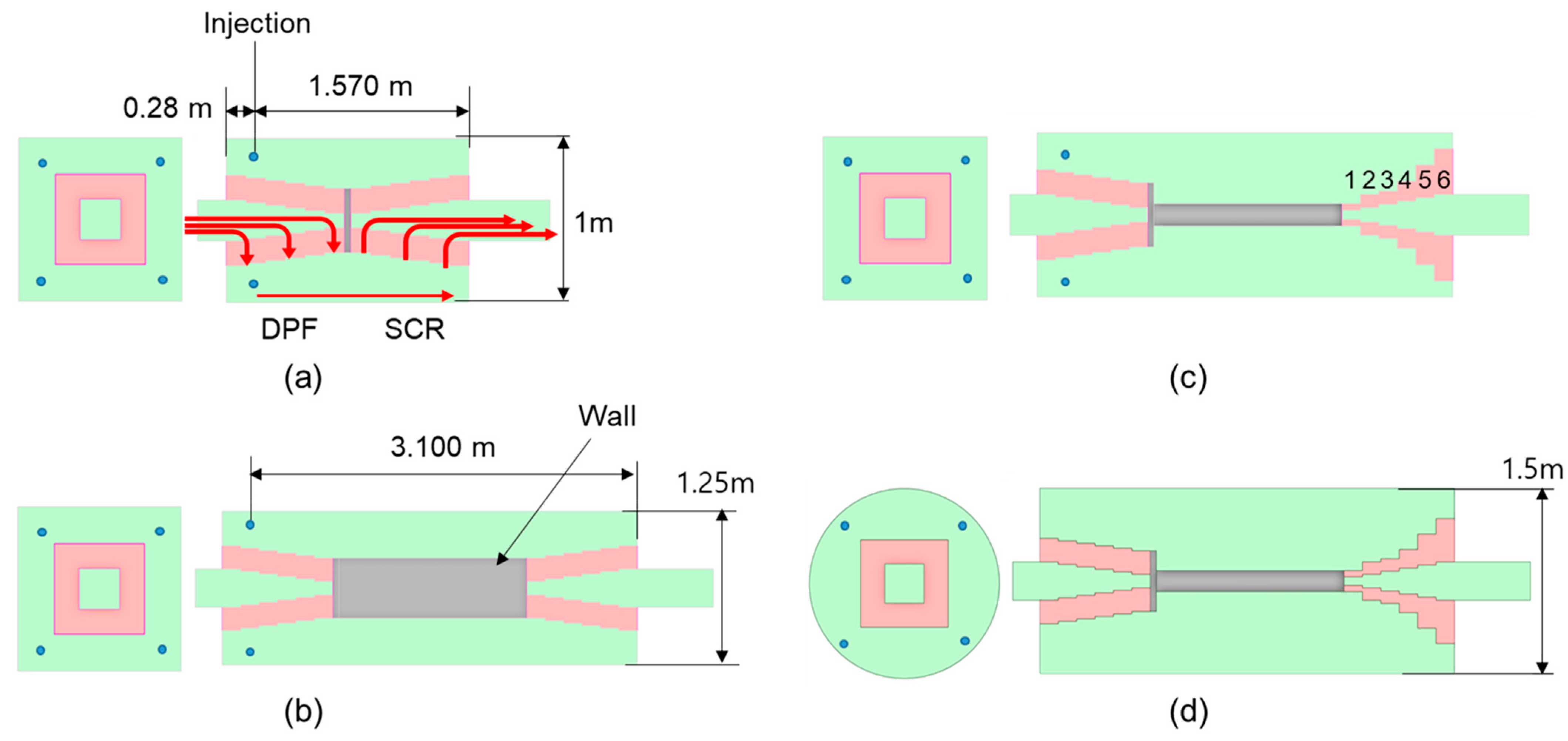
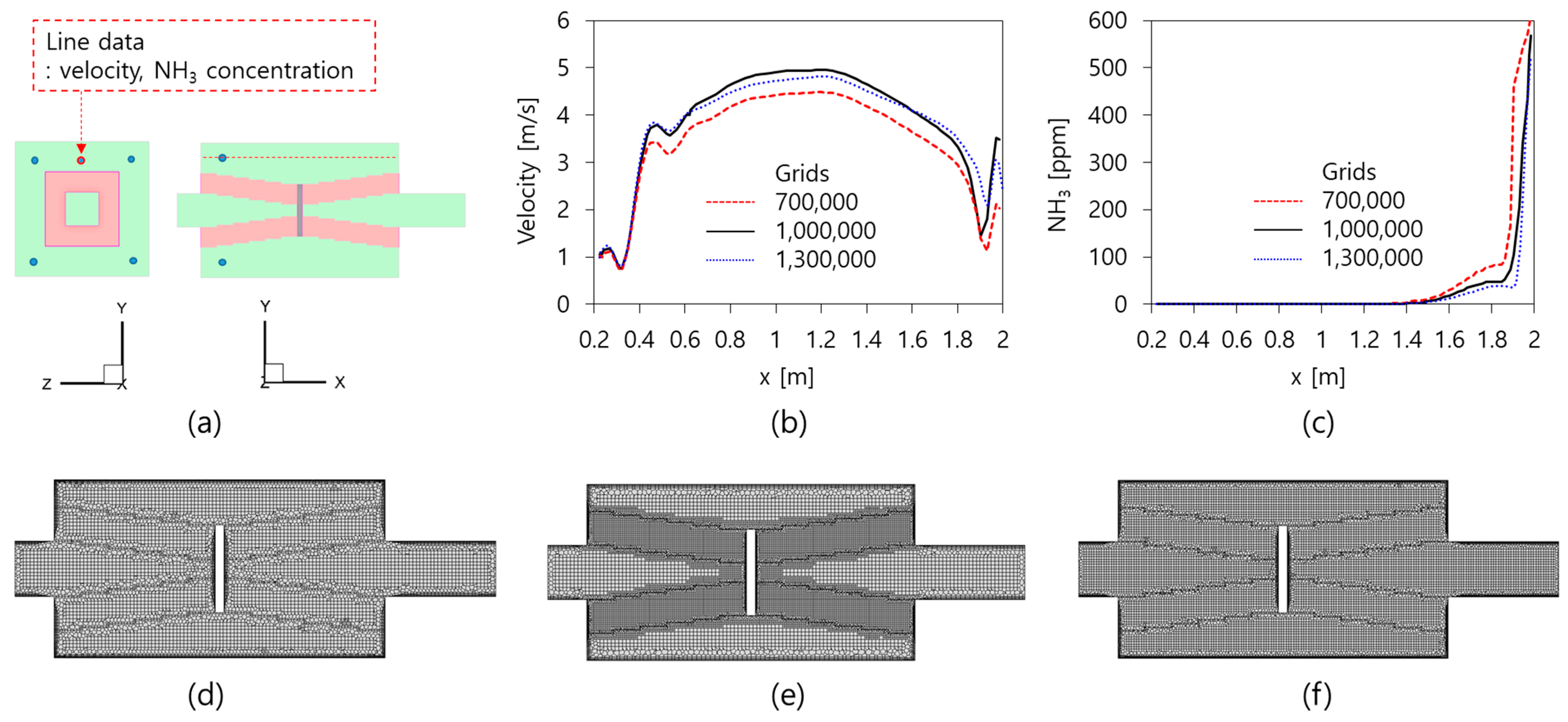
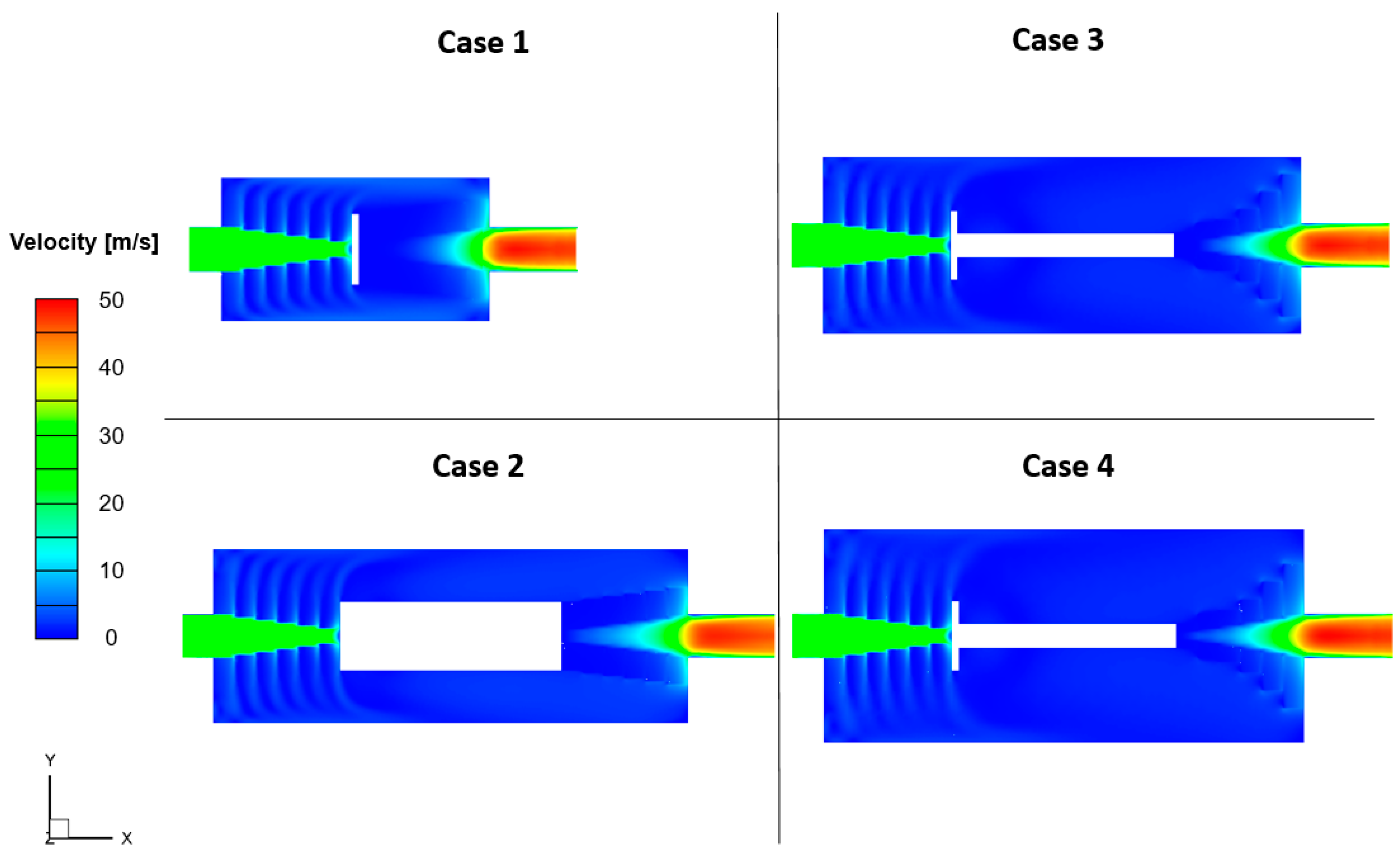
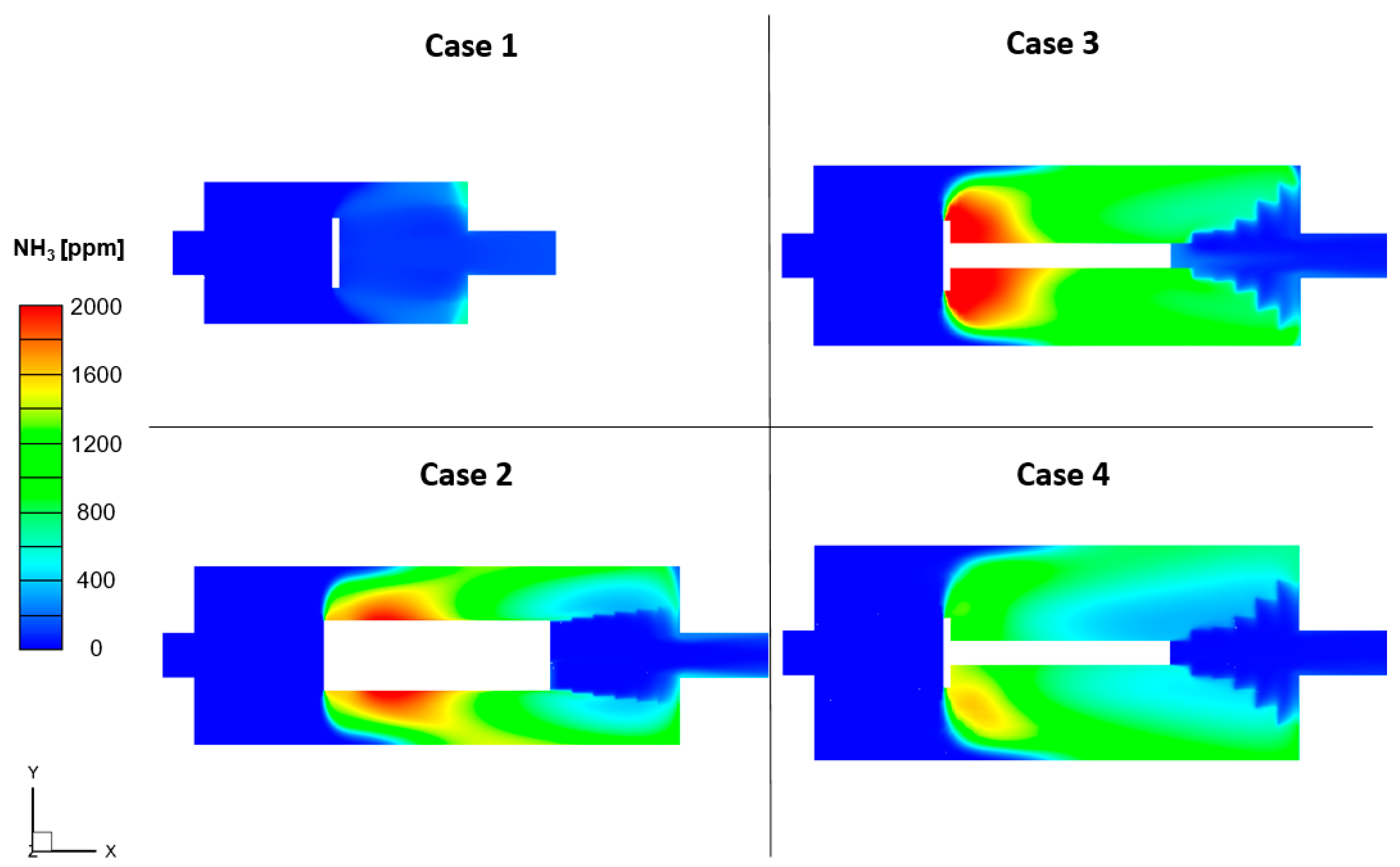
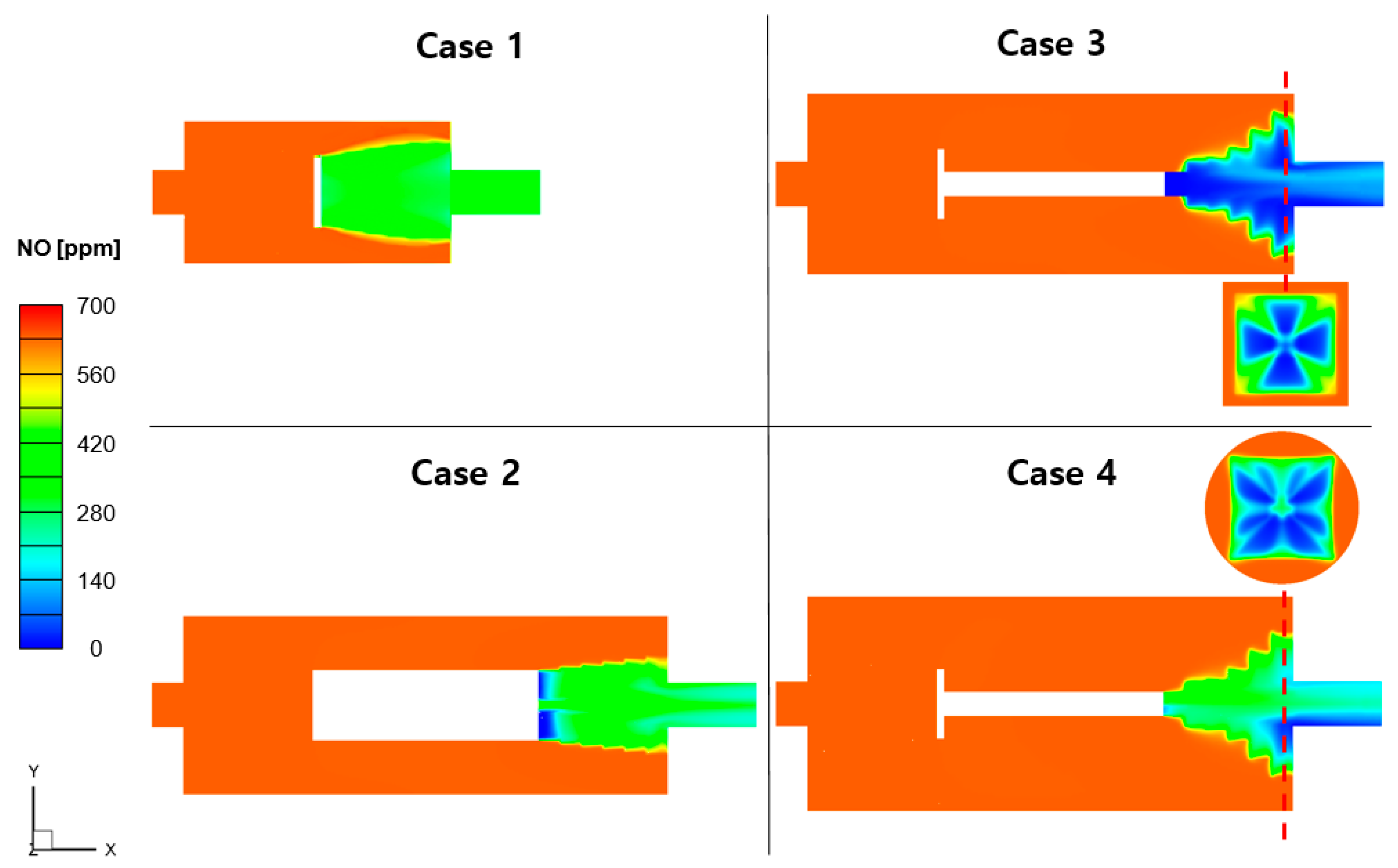

| Case No. | Length (m) | Height (m) | Catalyst Thickness (mm) | Mixing Chamber |
|---|---|---|---|---|
| Case 1 | 1.85 | 1 | 190 | Square |
| Case 2 | 3.380 | 1.25 | 190 | Square |
| Case 3 | 3.380 | 1.25 | 50, 100, 100, 150, 250, 350 | Square |
| Case 4 | 3.380 | 1.5 | 50, 100, 100, 150, 250, 350 | Circular |
| Reaction | Thermal Decomposition | Catalytic Decomposition | ||
|---|---|---|---|---|
| Pre-Exponential Factor | Activation Energy (J/kg·mol) | Pre-Exponential Factor | Activation Energy (J/kg·mol) | |
| Thermolysis | 4.9 × 103 | 2.3 × 107 | 4.5 × 103 | 2.26 × 107 |
| Hydrolysis | 2.5 × 105 | 6.22 × 107 | 3.1 × 104 | 1.58 × 107 |
| Reaction | Pre-Exponential Factor | Activation Energy (J/kg·mol) |
|---|---|---|
| 2.3 × 108 | 84.9 | |
| 1.9 × 1012 | 85.1 | |
| 1.1 × 107 | 72.3 |
Disclaimer/Publisher’s Note: The statements, opinions and data contained in all publications are solely those of the individual author(s) and contributor(s) and not of MDPI and/or the editor(s). MDPI and/or the editor(s) disclaim responsibility for any injury to people or property resulting from any ideas, methods, instructions or products referred to in the content. |
© 2023 by the authors. Licensee MDPI, Basel, Switzerland. This article is an open access article distributed under the terms and conditions of the Creative Commons Attribution (CC BY) license (https://creativecommons.org/licenses/by/4.0/).
Share and Cite
Choi, W.; Choi, S.; Na, S.; Shin, D.; Jeong, H.; Sung, Y. Numerical Study on Compact Design in Marine Urea-SCR Systems for Small Ship Applications. Energies 2024, 17, 187. https://doi.org/10.3390/en17010187
Choi W, Choi S, Na S, Shin D, Jeong H, Sung Y. Numerical Study on Compact Design in Marine Urea-SCR Systems for Small Ship Applications. Energies. 2024; 17(1):187. https://doi.org/10.3390/en17010187
Chicago/Turabian StyleChoi, Wontak, Seunggi Choi, Sangkyung Na, Dongmin Shin, Hyomin Jeong, and Yonmo Sung. 2024. "Numerical Study on Compact Design in Marine Urea-SCR Systems for Small Ship Applications" Energies 17, no. 1: 187. https://doi.org/10.3390/en17010187
APA StyleChoi, W., Choi, S., Na, S., Shin, D., Jeong, H., & Sung, Y. (2024). Numerical Study on Compact Design in Marine Urea-SCR Systems for Small Ship Applications. Energies, 17(1), 187. https://doi.org/10.3390/en17010187







